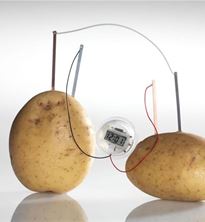

Take, for example, a plant of the most loved: the tomato. In southern Florida, where these plants are cultivated fields in winter most of the tomatoes to the east coast of the United States, producing 396,000 tons of organic waste, especially tomatoes salable. This surplus of decomposition of plant in landfills produces methane or generate problems of wastewater treatment, if spilled in water.
Tomatoes, however, are rich in lycopene, a powerful antioxidant, which has also proved a good mediator for electric charges. Researchers have developed microbial fuel cells (microbial fuel cell or MFC) tomato, which operate using electrons produced when bacteria decompose organic matter, have great potential as power generators. Early studies have shown that 10 milligrams of tomato waste can generate a power of 0.3 watts: very little, but the authors believe that further research will lead to an increase of several orders of magnitude. Furthermore, they argue, rotten tomatoes transmitters are even better than those who are still edible, which means it would be necessary to sacrifice the tomatoes used.
It will not be easy, of course, implement large-scale projects, says Namita Shrestha, one of the researchers who worked on the project. "large electrodes may be less efficient than the laboratory" for example, However, the benefits could be substantial. The annual waste of South Florida tomatoes, says the researcher, could, for example food Disney World for three months.
Although high-tech solutions such as fuel cells are gaining ground, even most of the solutions of "poor" might be promising. Some researchers are exploring the potential of a hitherto limited to educational experiments device: battery with potato. They found that "Desiree" potato with yellow flesh and red skin extended in the world unless it is boiled, increases its current transmission power up to ten times.
Such studies can be particularly useful in rural areas of developing countries, which often lack the electricity transmission network, but not agricultural products. More and more people have to rely on batteries of all kinds, and based on the tuber seem competitive: it is estimated that with a stack of potato would be possible to generate power at a cost of about $ 9 per kilowatt-hour, compared with 68 by a C battery and a lithium 1,200 for Patle electricity networks in the country may be rare, but not agriculture. And while increasingly common devices of all kinds are battery powered, potatoes offer a source of economic energy. The current produced by a potato-based batteries cost about $ 9 per kilowatt-hour. Researchers have not yet determined whether the potatoes rot even more powerful, but since the annual surplus of the United States - about 1.3 million tons, according to the Department of Agriculture statistics - would be a powerful source of energy.
Source: http://www.nationalgeographic.it